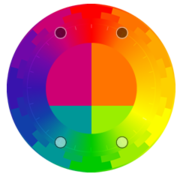Dual color scheme
Dual is a color scheme using two sets of base color and their complements. Both base colors are equivalent, cannot be decided which one should be the main color (though a designer could choose one). Less distance between two base colors causes less tension in the result. However, this scheme is always more "nervous” and “action” than other schemes. While working with it, we have to take care especially of relations between one color and the complement of its adjacent color.
A special variant ot the dual scheme is the tetrad — the foursome of colors evenly distributed on the fourths of the color wheel (by 90 degreees). The tetrad is very aggressive color scheme, requiring very good planning and very sensitive approach to relations of these colors.
Examples
We can use the dual scheme for calmer palettes with very close base colors, as well as less calm palettes using bigger distance.
Paletton usage
Within the Paletton application use the Tetrad (4-color) option to create dual schemes. Set the distance from the base color complement by dragging one of those two supplement color, or by clicking the angle gadget and entering the value manually. The less the value is, the closer the base colors and thei complements are, and the less tension is there. The best values are typically between 15—45°. The distance of 90° makes the tetrad.




